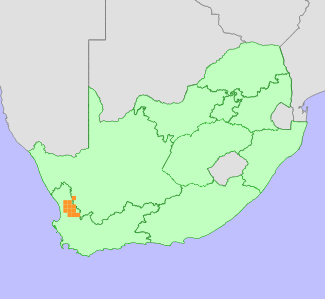|
Scientific Name | Conophytum minusculum (N.E.Br.) N.E.Br. subsp. minusculum |
Higher Classification | Dicotyledons |
Family | AIZOACEAE |
Synonyms | Conophytum herrei Schwantes, Conophytum minusculum (N.E.Br.) N.E.Br. var. paucilineatum Rawé, Conophytum minusculum (N.E.Br.) N.E.Br. var. reticulatum (L.Bolus) Rawé ex G.D.Rowley, Conophytum minusculum (N.E.Br.) N.E.Br. var. reticulatum (L.Bolus) Rawé ex G.D.Rowley forma reticulatum, Conophytum minusculum (N.E.Br.) N.E.Br. var. reticulatum (L.Bolus) Rawé ex G.D.Rowley forma roseum (G.D.Rowley) G.D.Rowley, Conophytum minusculum (N.E.Br.) N.E.Br. var. roseum (G.D.Rowley) Tischer, Conophytum reticulatum L.Bolus, Conophytum reticulatum L.Bolus forma roseum G.D.Rowley, Mesembryanthemum minisculum N.E.Br. |
National Status |
Status and Criteria | Endangered A3d |
Assessment Date | 2021/11/30 |
Assessor(s) | A.J. Young, P.G. Desmet, I. Ebrahim, D. Guo, A. Harrower, L. Jabar, L. Knoetze, C. Rodgerson, P.C.V. Van Wyk & N.N. Mhlongo |
Justification | This succulent is endemic to the Western Cape of South Africa with an extent of occurrence (EOO) of 3,483 km2 and area of occupancy (AOO) of 160 km2. While this particular taxon is not currently threatened by poaching, it is likely that it will become a target in coming years as most other species in the genus have been targeted in recent years. Since plants are distributed across numerous locations, many of which are in remote and difficult to access areas future declines due to collection are not likely to exceed 60% of the population within the next three generations (90 years). Climate change is also likely to impact the population although there is uncertainty in the degree of the decline given the resilience of this species. Based on levels of declines expected from illegal collection this species qualifies as Endangered under criterion A3. |
Distribution |
Endemism | South African endemic |
Provincial distribution | Western Cape |
Range | This succulent is endemic to the Western Cape of South Africa. |
Habitat and Ecology |
Major system | Terrestrial |
Major habitats | Fynbos, Succulent Karoo |
Description | This succulent is primarily found in the Fynbos biome (especially the Sandstone Fynbos and Shale Renosterveld bioregions) but is also present in the Succulent Karoo biome. It is predominantly found on weathered quartzitic sandstone amongst moss and lichen or in shallow sandy-grit filled depressions. It has a generation length of 30 years. It is expected to be sensitive to the impacts of climate change as it does not disperse and while adapted to arid conditions, is dependent on limited seasonal rainfall. Species in the genus are sensitive to long periods of drought. Drought related mortality has been observed for other closely related taxa within the genus. |
Threats |
| This particular taxon is not currently threatened by illegal collection but it is likely that it will become a target in coming years as there has been a dramatic increase in the number of species and volume of plants of this genus targeted since 2019. Related species, including other subspecies from the same species, have experienced severe declines in population number due to illegal collection. As a result a population decline of 50-60% is suspected over three generations (90 years).
Anthropogenic climate change is a long-term threat to this taxon. There is no decline in habitat quality for this taxon as inferred by changes in vegetation cover determined from changes in Enhanced Vegetation Index (EVI) between 1984 and 2018 using Landsat data (Venter et al. 2020). Climate models for the likely emission scenarios where emissions stay at present day levels (RCP 2.6) (Hausfather and Peters 2020) and worst case scenarios where emissions continue to increase during the 21st century (RCP 8.5) indicate that there will be a loss of suitable bioclimatic envelope of between 48% and 57% by 2080 for this taxon. However, as this taxon occurs across several vegetation units it is expected to have a level of resilience to climate change and the expected population loss is reduced by 20% to 28%. Species in this genus have limited dispersal ability and migration to suitable habitats elsewhere is regarded as highly unlikely. |
Population |
This taxon is found in numerous subpopulations where it is typically very locally abundant, often forming dense colonies. There are no formal estimates of population size for this succulent but the number of mature individuals is suspected to be between 100,000 and 200,000 mature individuals. The population trend is unknown but may be declining as a result of drought related mortality caused by climate change.
|
Population trend | Decreasing |
Assessment History |
Taxon assessed |
Status and Criteria |
Citation/Red List version | | Conophytum minusculum (N.E.Br.) N.E.Br. subsp. minisculum | Least Concern | Raimondo et al. (2009) | |
Bibliography |
Hammer, S. 2002. Dumpling and his wife: New view of the genus Conophytum. EAE Creative Colour, Norwich.
Hammer, S.A. 1993. The genus Conophytum: A conograph. Succulent Plant Publications, Pretoria.
Hausfather, Z. and Peters, G.P. 2020. Emissions - the 'business as usual' story is misleading. Nature 577(618-620).
Opel, M.R. 2004. The rediscovery of Crassula alcicornis. Haseltonia 10:38-40.
|
Citation |
| Young, A.J., Desmet, P.G., Ebrahim, I., Guo, D., Harrower, A., Jabar, L., Knoetze, L., Rodgerson, C., Van Wyk, P.C.V. & Mhlongo, N.N. 2021. Conophytum minusculum (N.E.Br.) N.E.Br. subsp. minusculum. National Assessment: Red List of South African Plants version 2024.1. Accessed on 2025/12/13 |
 Comment on this assessment
Comment on this assessment


